The ultimate guide to Competitive Pricing – definition, advantages, and disadvantages
- 07 November 2022
Product pricing is one of the toughest and at the same time one of the most crucial aspects of business operations – both to brands and e-stores. Price optimization and smart price management are the factors that actually make a great difference in terms of profit and revenues generated by companies. We can reach out for various pricing strategies – and one of them is competitive pricing. How does it work and how to use it effectively?
What is Competitive Pricing?
Competitive pricing is a product pricing method based on the prices of one’s competitors. In practice, it boils down to searching for optimal price points with reference to other products available on the market. It allows companies to position their products both in line with market trends and set their price level which is lower or higher than the one of their competitors. Thus, a brand, depending on the strategy adopted, may build an economy or premium brand, while the seller is able to optimize the offer against their competitors. The competitive pricing method is mostly applied when there are already substitutes of the marketed product available on the market and it is easy to compare the offers.

What are examples of competitive pricing?
Competitive pricing is not only about the price. This paradox lies in your brand – the more recognizable and strong it is, the more options you have to become competitive. Let’s take a look at some competitive pricing examples.
- Define your uniqueness.
Be like Apple – sell what makes you one-of-a-kind. Your unique advantages not only will stand you out from competitors, but also will allow you to set value-based pricing. In other words, your originality will justify even a high price of your products. - Follow your buyer’s persona.
As a retailer certainly you’ve heard about clients’ personas. Do you know who is your target? Follow their needs and desires. Create their profile including demography, age, gender, income, and any other data that let you recognize how much your customers are willing to pay. - Create a sense of urgency.
Have you ever noticed that when you scroll Booking to find a room there is also information about recent viewers and available offers? Don’t you feel a bit tense when you find out that there is only one place left in your preferred hotel? That is exactly what we call a sense of urgency. Limited time or a number of items forces you to make up your mind faster and complete a purchase as soon as possible. - Deliver social proof.
This psychological phenomenon defined by Robert Cialdini is also commonly used in marketing. Nowadays, it’s more than obvious that clients check the products’ opinion before the purchase. However, good reviews are not enough. It’s also a number that matters. The higher the number, the bigger the number of satisfied clients. To boost your credibility you can also add any decorations or top seller badges. Make your clients feel secure and taken care of. - Every penny matters.
Would you rather buy a product for $4,99 or $5? Of, course most of us would choose the first option. Thus, when setting prices or pricing rules, try to opt for the number that changes perception. In psychology, that’s called “the left-digit effect”. According to a survey conducted in 2005, the first number we see (so, the number on the left) affects our perspective drastically. That’s why the difference between $7,30 and 7,39 doesn’t seem significant, but on the other hand, our brain spots a huge contrast between $4,99 and $5,00.
8 Best Competitive Pricing Strategies for E-commerce
Cost-based pricing
This strategy will work perfectly with beginners. Cost-based pricing focuses more on the sellers’ side than on the consumers’. You just take the product’s production cost, add your margin, and … done.
So let’s say you are selling an item that costs you $20. Then you add expenses on your side: hosting & platform fees, packaging, and shipping – $10 in total. However, you’d also like to make a $5 profit on every purchase. Therefore, the total amount your client needs to pay equals $35.
This strategy doesn’t require any advanced knowledge and is pretty easy to use. Nevertheless, as you don’t take your clients’ pricing preferences into consideration, the price you offer not always will be the one the buyers are willing to pay.
Companies examples: Ryanair and Walmart.
Competitor-based pricing
In this strategy scenario, the crucial reference is your competitor. Thus, before employing a competitor-based pricing strategy you need to do some research first. And that’s the tricky part. First of all, when it comes to the e-commerce industry, the competition is extremely fierce. So you need to prepare wisely. Instead of analyzing the market manually, use a competitor monitoring software, e.g. Dealavo.
Your next step is to identify your biggest competitors and review their prices.
However, remember that being the cheapest is not always the best choice. Many begging retailers set the cheapest prices to become competitive and attract customers, but at the same time, they forget about controlling the margin. Hence, as a result, your offer may be the cheapest, but it doesn’t mean you will gain any satisfying profit.
Price-skimming
Skimming is a pricing strategy sometimes also referred to as creaming. A product is launched at a high price and is dedicated to customers with low price sensitivity. The customers are usually well-off, and they want to get the new product as quickly as possible. After some time, the price of the product decreases, and it becomes available to customers who are more sensitive to prices.
The most popular example of such a manufacturer is Apple. We recommend reading our article: How does Apple use being a luxury brand? to see how the skimming strategy works in practice.
Bundle Pricing
Are you interested in boosting your e-commerce sales? If yes, try a Bundle Pricing strategy. The goal is to create multiple sales by offering a bunch of related products at a lower price instead of one. Thanks to this approach you can also increase your average order value, also known as AOV.
Bundle Pricing is a win-win solution for both: retailers and buyers. Your e-store sells more and consequently makes a bigger profit. On the other hand – your client doesn’t need to cover multiple shipping costs and receive a few items at a reduced price.
Dynamic Pricing
For many e-sellers time is money, and by “time” we mean “seconds”. While buying online what matters the most is the price – customers usually use price comparison websites to choose the cheapest retailer. In that case, even a few cents may make a difference and bring a profit or a loss.
That’s where Dynamic Pricing may come in handy. The core of this strategy is to react immediately to market fluctuations and adjust the prices accordingly. Thus, retailers can keep their profit and stay competitive regardless of the changes. However, the Dynamic Pricing strategy works only when it’s fully automated. Otherwise, it may turn out to be not only time-consuming but also error-prone and unreliable.
Therefore, when looking for competitive pricing software, choose those with a Dynamic Pricing feature.
Value-based Pricing
Have you ever wondered why people can pay a fortune just for a scarf, a phone, or a car? It’s not because of its exceptional functionalities (well… maybe sometimes it is). What matters the most is the non-market value the product gives. This pricing strategy is extensively used in the fashion and luxury commodities industry. If your brand is strong, creates a sense of belonging to a particular community, or just fulfills your clients’ craving for an unexceptional experience, you don’t need to worry about the economics or even your competitors. The value of your product is much beyond its actual market price. Great examples are Louis Vuitton, Apple, and Starbucks.
Loss-leader pricing
Loss leader pricing is usually based on one particular product that’s referred to as a loss leader. This product has but one purpose – to attract as many potential customers as possible. Companies using loss leaders don’t make any money on selling them. Frequently these products even generate loss! How is that profitable? When the loss leader does its job correctly, customers order more products that are no longer so affordable. This way, the store can make up for this loss generated by the loss leader with other products in their offer.
Thanks to loss-leader pricing, of course, you can drive more traffic to your store but in practice, this strategy may appear a bit risky. It’s not a secret that buyers look for the cheapest offer on the product they want to purchase. Therefore, many platforms, e.g. Google Shopping, provide facilitations to bargain hunters, to make the searching easier and faster. As a consequence, it may turn out that the only item customers buy from you is nothing else but your loss leader.
Last but not least – in some countries, such practices are recognized as illegal.
Penetration Pricing
A penetration strategy is when you intensify sales thanks to setting lower prices. The aim of this strategy is to gain the biggest possible share of the market. It is particularly popular when launching a new product. This is when manufacturers sometimes decide to set low prices. One of the biggest advantages of this pricing strategy is the rapid increase in market share after setting affordable prices in comparison to the competition.
A perfect example of the penetration strategy was the entry of Huawei products into the European market. The company gained a big market share by offering relatively low prices and good quality at the same time.
The continuous development of e-commerce means that sellers have to face increasing competition. In order to stand out from the crowd, they reach for various types of pricing strategies that allow them to adjust their offers to the current market situation. In this guide, we will present you with the most important expert tips on competitor price monitoring and competitive prices.
Benefits of keeping track of the market trends and changes in prices
By monitoring market trends and adjusting your prices on an ongoing basis, you can gain a lot. Potential benefits occur in many different fields, such as, but not limited to:
- Competitive advantage — thanks to the price monitoring tool, you are able to adjust your sales strategy and stay ahead of your competitors in terms of pricing.
- Improved profitability — by using a tool like Dealavo, you can identify opportunities to increase profit margins and adjust your pricing strategy accordingly.
- Better decision-making — this includes identifying the optimal price for your products, identifying opportunities to offer promotions, and adjusting strategy based on customer behavior.
- Improved customer satisfaction — you can offer competitive pricing that is in line with users’ expectations, which can lead to increased loyalty and higher customer lifetime value.
- Reduced risk — it includes identifying pricing trends that could impact profitability, as well as identifying pricing strategies used by competitors that could impact market share.
What is competitor price monitoring, and How can you achieve competitive prices with it?
Competitor price monitoring is the process of continuously tracking and analyzing the offers of your competitors’ products or services. This helps you to understand the pricing strategies of your rivals and how they are positioning themselves in the market.
Competitor price monitoring is important for your business for several reasons:
- Price positioning — by analyzing the prices of your competitors, you can determine whether your offers are competitive or whether you need to adjust your pricing strategy.
- Identifying trends — if you notice, for example, that your competitors are lowering their prices, it may be an indication that the market is becoming more competitive.
- Strategic planning — by understanding the pricing strategies of your competitors, you can make informed decisions about product development, marketing, and sales.
Maximizing profits — you can adjust your prices to be competitive while still maintaining a healthy profit margin.
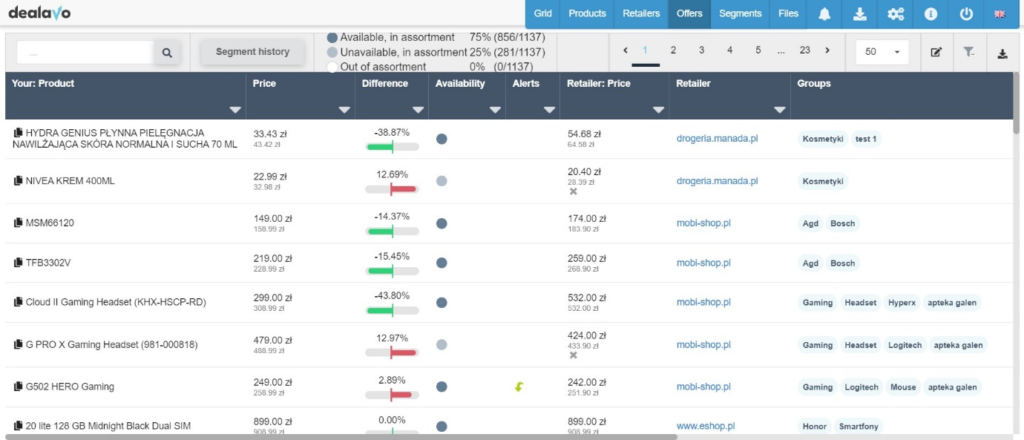
Price monitoring vs. competitive pricing
Both price monitoring and competitive pricing have a lot in common. First and foremost, they focus on price comparison and fluctuations tracking. However, price monitoring is a much broader term that refers not only to monitoring competitors’ prices. We can still track our products’ prices, even though there are no substitutes available on the market, especially when it comes to new marketing campaigns or product promotions. On the other hand, the core of competitive pricing is competition. That’s why we simply cannot implement competitive pricing without adversaries.
How to identify your competitors and track their prices?
To successfully develop a pricing strategy for your business, it is important to identify and track your competitors’ prices. This can be done through a systematic process that involves several steps.
Firstly, you need to identify who your competitors are. Look for businesses that offer similar products or services in the same market. This can be achieved through market research or using competitor analysis tools like Google Alerts, SEMRush, or Ahrefs. Once you have identified your competitors, you should start monitoring their prices. To do this, you can visit their websites regularly or use smart price tracking tools such as Dealavo.
Learn more about Dealavo
To stay current on your competitors’ activities and pricing strategies, it is important to conduct regular market research. This can involve monitoring industry publications, attending industry events, and conducting customer surveys. Using a price intelligence tool like Dealavo can also help streamline this process. This type of tool automates data collection and analysis, provides real-time competitor pricing information, and generates insights to help you optimize your sales strategy.
Tips on gaining access to your competitors’ pricing data
When it comes to gaining access to your competitors’ pricing data, there are several tips that can help you achieve this effectively:
- Use a price intelligence tool like Dealavo — the tool can automatically collect and analyze pricing data from multiple sources and provide you with real-time insights into your competitors’ strategies.
- Monitor competitors’ websites — you can manually check their prices and take note of any changes or promotions. Dealavo also allows you to track such changes automatically.
- Monitor online marketplaces — if your competitors sell their products on online marketplaces such as Amazon or eBay, you can monitor their prices on these platforms as well.
- Monitor social media — some competitors may use social media platforms such as Facebook or Twitter to promote their products. By monitoring these channels, you can gain insight into their pricing strategies and identify any upcoming promotions.
- Conduct customer surveys — ask your customers about their shopping behavior and their perception of your competitors’ offers. This can provide valuable information that can help you adjust your own pricing strategy.
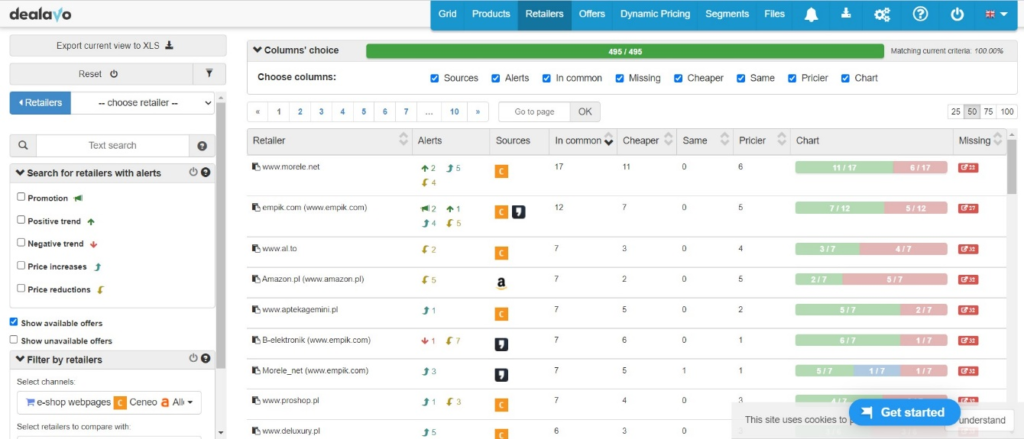
The impact of technology on competitor price monitoring
Technology has revolutionized the way businesses monitor their competitors’ prices. In the past, it involved a lot of manual work, such as surveys or in-store visits. However, with the advent of technology, companies now have access to tools that can automate the process of collecting and analyzing pricing data.
One of the key impacts of technology on competitor price monitoring is automation. Tools like Dealavo can automatically collect pricing data from various sources, including online stores and marketplaces. This allows businesses to access real-time pricing data while saving time and money.
Another impact of technology on competitor price monitoring is increased accuracy. Applications like Dealavo can collect data more precisely than manual methods, reducing the risk of errors and providing more reliable information. This accuracy enables businesses to make better-informed pricing decisions.
Finally, technology has made it easier to monitor a larger number of competitors. With automated tools, companies can track prices from multiple rivals simultaneously, gaining a broader overview of the market.
Strategies for keeping up with the latest price changes from your competitors
In conclusion, thanks to price monitoring tools, your company can always be one step ahead of the competition. Just reach for an application such as Dealavo and include the following actions in your strategy:
- Set up automated price alerts — you can set up price alerts to receive notifications when your competitors change their offers. This will help you stay informed and react quickly.
Keep up with market changes thanks to price alerts!
- Monitor your competitors’ pricing history — thanks to Dealavo you can see how various prices have changed over time. This will help you identify any patterns or trends in competitors’ pricing strategies and adjust your offers accordingly.
- Analyze customer shopping behavior — by collecting data on customers’ visits to your store and their transactions, you can efficiently adjust your offers and marketing activities to the needs of specific users. This will increase your conversion rate and customer satisfaction.
By following our tips, you will easily stand out on the market and ensure a constant flow of new customers! Do you want to give our platform a shot? Request a demo today!
5 Indispensable Competitive Pricing Tools
Dealavo
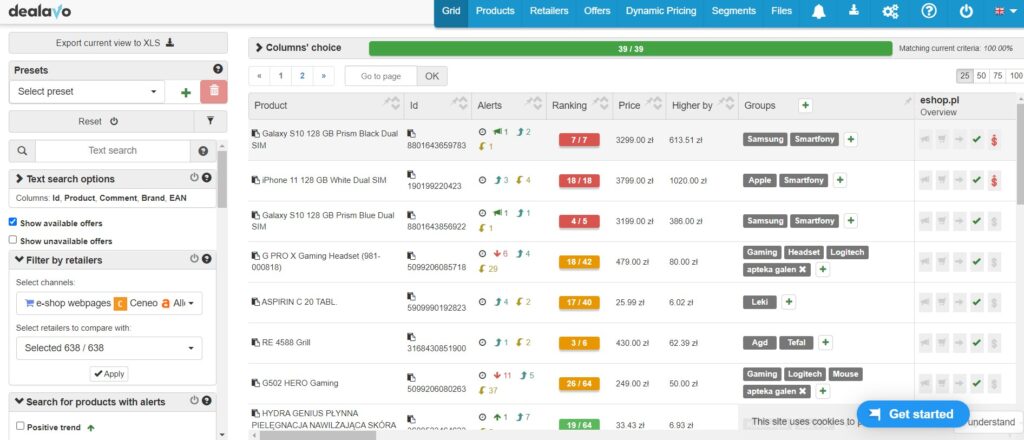
Dealavo is a price monitoring tool that certainly distinguishes itself from other pricing monitoring software providers. It’s designed for brands and e-shops and combined with advisory services, such as Dynamic Pricing.
Dealavo platform allows brands to monitor the prices of their products across channels and quickly spot MAP/MSRP violations in e-shops, marketplaces, and price comparison websites worldwide.
With Dealavo you will easily track the implementation of your pricing strategy by key channel partners and act on any possible violations. Aggregated data allows you to benchmark your channels and helps you choose the best partners for future cooperation.
Pros:
- free trial version,
- many useful integrations, e.g. Amazon, WooCommerce, IdoSell
- Dynamic Pricing feature,
- customized free & paid reports, e.g Competitor’s Assortment Report
- twofold structure – for brands and e-shops,
- full customer success support.
Cons:
- challenging admin panel, not best for beginners
- some features may perform slowly.
Prisync
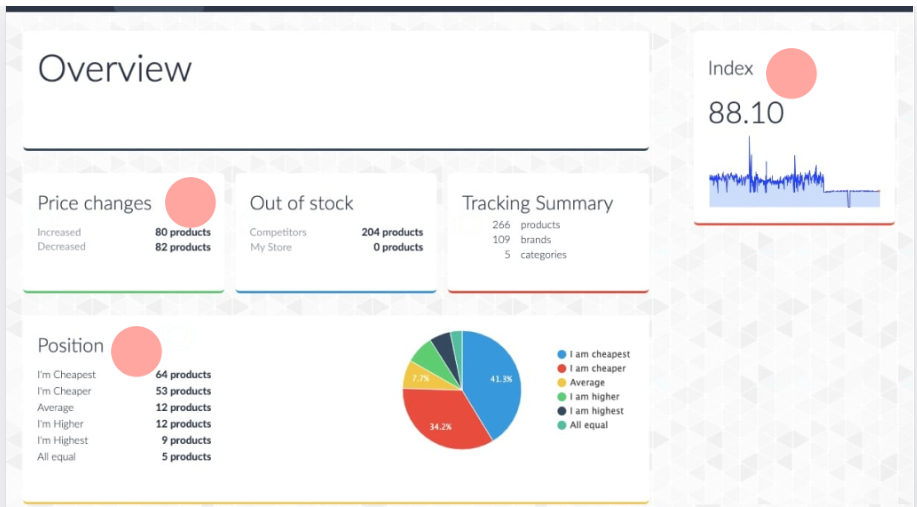
Prisync is a popular Could-based solution that focuses mainly on Competitor’s Prices Tracking for e-shops. Thanks to undetectable bots the app provide reliable and safe data. Among standard solutions such as e-mail alerts or price history charts, this software offers also advanced features, including Dynamic Pricing along with Recommended Price Suggestions.
For those, who are not convinced, and would like to try it out, Prisync came up with a 14-day free trial.
Pros:
- 14-day free trial,
- Dynamic Pricing feature,
- flexible pricing, with no commitments.
Cons:
- no API for the basic plan,
- possible delays in reporting,
- lack of banner, promotion, or offline stock monitoring.
See the differences between Prisync and Dealavo.
Omnia Retail
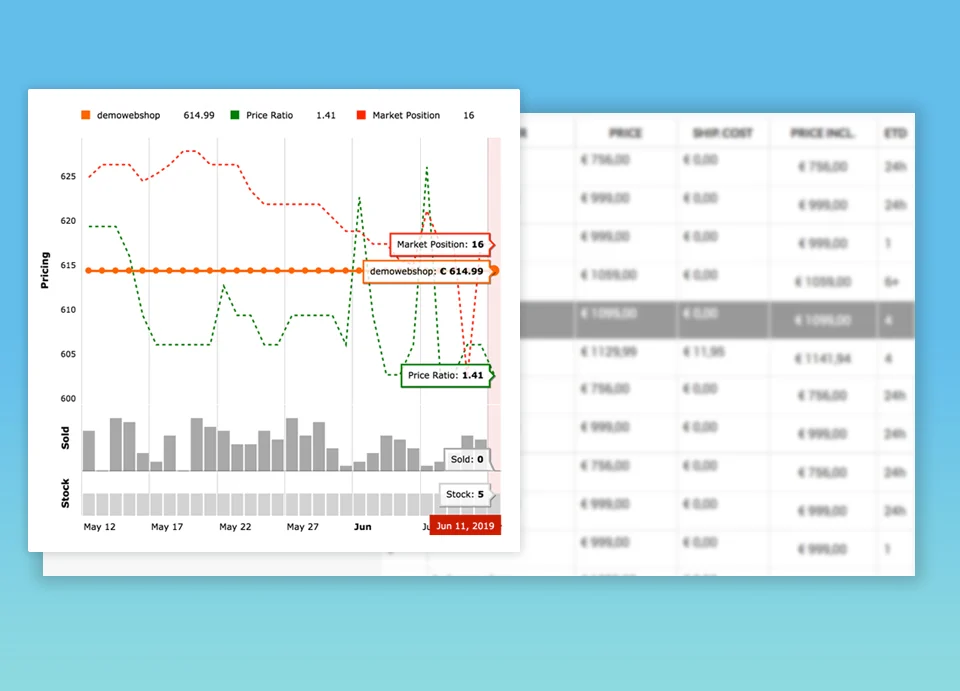
Omnia Retails is another Saas solution that helps retailers take control of their pricing and increase the profit which is much easier thanks to automation and deep-in insights. The app is built on two main products – Dynamic Pricing & Pricewatch and provides devoted Customers Success support.
Pros:
- flexibility in setting pricing rules,
- price updates 4 times a day,
- strong customer success support.
Cons:
- limited features,
- free trial available.
Check the differences between Dealavo and Omnie Retail.
Wiser
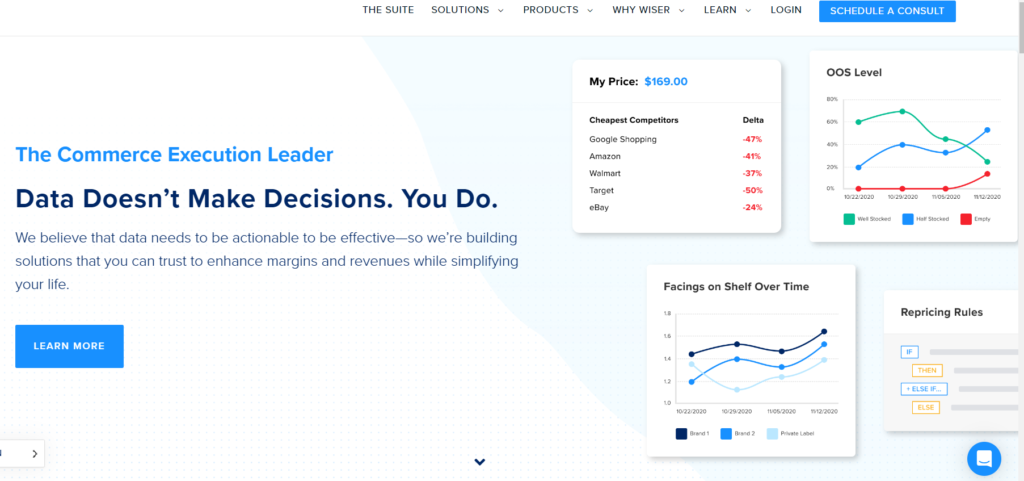
If you are looking for advanced software that will help you with Price Optimization, Brand Intelligence, and Customer Experience, Wiser is for you. The app guarantees real-time, actionable pricing data for brands and retailers to identify the competitive landscape and ensure competitiveness. By combining price intelligence with the repricing engine Wiser makes your pricing fully automated and error-risk free.
Pros:
- advanced Price Optimization & Marketing solutions,
- strong Customer Experience approach.
Cons:
- set-up may be challenging for new users,
- lack of double verification – sometimes manual checking is required.
Check Wiser alternative.
PriceGrid
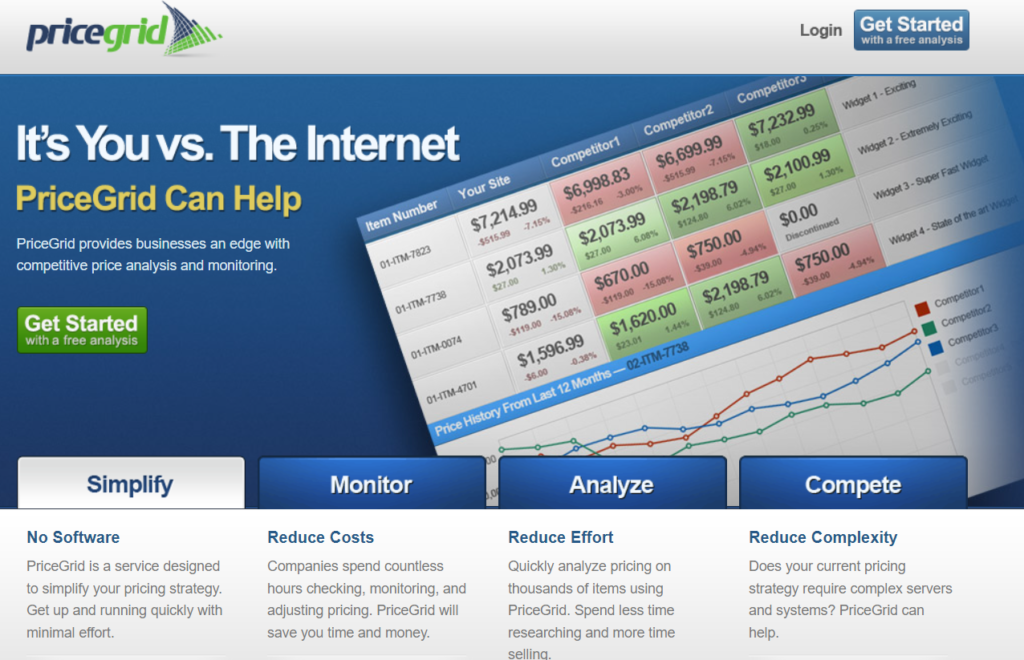
Located in the U.S., PriceGrid is a Cloud-based price monitoring software, that operates on a SaaS license. PriceGrid’s strategy is based on simplifying, monitoring, analyzing, and competing. With the supportive and knowledgeable helpdesk, this software’s only drawback is perhaps a lack of a free trial. Undoubtedly, one of the most distinctive features of this software is researching prices in seconds.
Pros:
- user-friendly and intuitive,
- reasonable price,
Cons:
- no free trial,
- lack of depth-in reports.
See how to compare Dealavo and Pricegrid.
Summary
If you are an e-commerce retailer certainly you should give competitive pricing a try. It’s a complex approach that gives merchants a range of possibilities, depending on e-store needs.
Hopefully, with this ultimate guide, we answered all of your questions regarding this matter.
Looking for reliable competitive pricing software? Check out Dealavo. Our app guarantees you verified, and up-to-date market data about competitors and prices. Thanks to a Dynamic Pricing feature along with a handful of reports as well as e-commerce services, you may be sure your store will stand out from the competition.